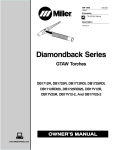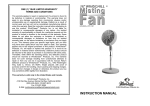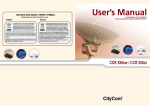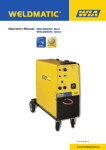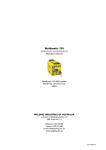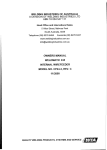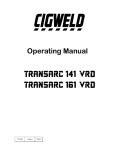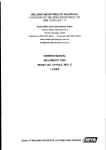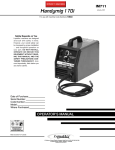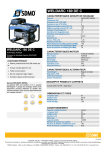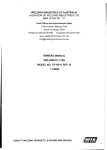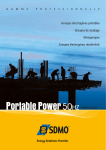Download WELDING INDUSTRIES 145i MC92-0 Specifications
Transcript
Weldarc Inverter Series Operators Manual Weldarc Manual Arc/TIG welders Weldarc 125i – Model No. MC91-0, Iss A Weldarc 145i – Model No. MC92-0, Iss A Weldarc 165i – Model No. MC93-0, Iss A 05/07 WELDING INDUSTRIES OF AUSTRALIA a division of Welding Industries Ltd ABN 18 004 547 111 Telephone 1300 300 884 Facsimile 1300 301 884 Email: [email protected] www.welding.com.au MC91-40 Rev C Weldarc 125i, 145i, 165i Operators Manual Contents Section General Information Model No. MC91-0, MC92-0, MC93-0 Iss A 05/07 Page Safe Practices 3 1 Introduction 5 2 Receiving 5 3 Specifications 6 4 Power Source Controls 7 5 Operation 8 6 Installation 8 7 MMAW Welding 9 8 GTAW Welding 10 9 General Maintenance 11 10 Trouble Shooting 11 11 Service Information 12 12 Assembly and Parts Lists 14 13 Warranty information 16 Quality, Reliability, Performance Weldarc 125i, 145i, 165i Operators Manual Read First The information contained in this manual is set out to enable you to properly maintain your new equipment and ensure that you obtain maximum operating efficiency. Please ensure that this information is kept in a safe place for ready reference when required at any future time. When ordering spare parts, please quote the model and serial number of the power source and part number of the item required. All relevant numbers are shown in lists contained in this manual. Failure to supply this information may result in unnecessary delays in supplying the correct parts. Safety Before this equipment is put into operation, please read the Safe Practices section of this manual. This will help to avoid possible injury due to misuse or improper welding applications. Safe Practices When Using Welding Equipment These notes are provided in the interests of improving operator safety. They should be considered only as a basic guide to Safe Working Habits. A full list of Standards pertaining to industry is available from the Standards Association of Australia, also various State Electricity Authorities, Departments of Labour and Industry or Mines Department and other Local Health or Safety Inspection Authorities may have additional requirements. Australian Standard AS1674.2 provides a comprehensive guide to safe practices in welding. Eye Protection NEVER LOOK AT AN ARC WITHOUT PROTECTION. Wear a helmet with safety goggles or glasses with side shields underneath, with appropriate filter lenses protected by clear cover lens. This is a MUST for welding, cutting, and chipping to protect the eyes from radiant energy and flying metal. Replace the cover lens when broken, pitted, or spattered. Recommended Shade Filter Lens Plastic Handle on Welder Please note that the handle fitted to the Weldarc inverter is intended for carrying the equipment by hand only. DO NOT use this handle for suspending or mounting the Weldarc in any other manner. Amps TIG MMAW MIG Pulsed MIG 0-100 10 9 10 12-13 100-150 11 10 10 12-13 150-200 12 10-11 11-12 12-13 200-300 13 11 12-13 12-13 300-400 14 12 13 14 400-500 — 13 14 14 500 + — — 14 14 Burn Protection The welding arc is intense and visibly bright. Its radiation can damage eyes, penetrate lightweight clothing, reflect from light-coloured surfaces, and burn the skin and eyes. Burns resulting from gas-shielded arcs resemble acute sunburn, but can be more severe and painful. Wear protective clothing - leather or heat resistant gloves, hat, and safety-toe boots. Button shirt collar and pocket flaps, and wear cuffless trousers to avoid entry of sparks and slag. Avoid oily or greasy clothing. A spark may ignite them. Hot metal such as electrode stubs and work pieces should never be handled without gloves. Ear plugs should be worn when welding in overhead positions or in a confined space. A hard hat should be worn when others are Quality, Reliability, Performance Model No. MC91-0, MC92-0, MC93-0, Iss A 05/07 Weldarc 125i, 145i, 165i working overhead. Flammable hair preparations (hairspray) should not be used by persons intending to weld or cut. Toxic Fumes Adequate ventilation with air is essential. Severe discomfort, illness or death can result from fumes, vapours, heat, or oxygen depletion that welding or cutting may produce. NEVER ventilate with oxygen. Lead, cadmium, zinc, mercury, and beryllium bearing and similar materials when welded or cut may produce harmful concentrations of toxic fumes. Adequate local exhaust ventilation must be used, or each person in the area as well as the operator must wear an air-supplied respirator. For beryllium, both must be used. Metals coated with or containing materials that emit fumes should not be heated unless coating is removed from the work surface, the area is well ventilated, or the operator wears an air-supplied respirator. Work in a confined space only while it is being ventilated and, if necessary, while wearing airsupplied respirator. Vapours from chlorinated solvents can be decomposed by the heat of the arc (or flame) to form phosgene, a highly toxic gas, and lung and eye irritating products. The ultra-violet (radiant) energy of the arc can also decompose trichlorethylene and perchlorethylene vapours to form phosgene. Do not weld or cut where solvent vapours can be drawn into the welding or cutting atmosphere or where the radiant energy can penetrate to atmospheres containing even minute amounts of trichlorethylene or percholorethylene. Operators Manual Walls touching combustibles on opposite sides should not be welded on or cut. Walls, ceilings, and floor near work should be protected by heat-resistant covers or shields. A person acting as Fire Watcher must be standing by with suitable fire extinguishing equipment during and for some time after welding or cutting if; • Combustibles (including building construction) are within 10 metres. • Combustibles are further than 10 metres but can be ignited by sparks. • Openings (concealed or visible) in floors or walls within 10 metres may expose combustibles to sparks. • Combustibles adjacent to walls, ceilings, roofs, or metal partitions can be ignited by radiant or conducted heat. After work is done, check that area is free of sparks, glowing embers, and flames. A tank or drum which has contained combustibles can produce flammable vapours when heated. Such a container must never be welded on or cut, unless it has first been cleaned as described in AS.1674-2. This includes a thorough steam or caustic cleaning (or a solvent or water washing, depending on the combustible’s solubility), followed by purging and inerting with nitrogen or carbon dioxide, and using protective equipment as recommended in AS.1674-2. Water-filling just below working level may substitute for inerting. Hollow castings or containers must be vented before welding or cutting. They can explode. Never weld or cut where the air may contain flammable dust, gas, or liquid vapours. Fire and Explosion Prevention Shock Prevention Be aware that flying sparks or falling slag can pass through cracks, along pipes, through windows or doors, and through wall or floor openings, out of sight of the operator. Sparks and slag can travel up to 10 metres from the arc. Exposed conductors or other bare metal in the welding circuit, or ungrounded electrically alive equipment can fatally shock a person whose body becomes a conductor. Ensure that the equipment is correctly connected and earthed. If unsure have the equipment installed by a qualified electrician. On mobile or portable equipment, regularly inspect condition of trailing power leads and connecting plugs. Repair or replace damaged leads. Keep equipment clean and operable, free of oil, grease, and (in electrical parts) of metallic particles that can cause short circuits. If combustibles are present in the work area, do NOT weld or cut. Move the work if practicable, to an area free of combustibles. Avoid paint spray rooms, dip tanks, storage areas, ventilators. If the work can not be moved, move combustibles at least 10 metres away out of reach of sparks and heat; or protect against ignition with suitable and snug-fitting fireresistant covers or shields. Model No. MC91-0, MC92-0, MC93-0 Iss A 05/07 Fully insulated electrode holders should be used. Do not use holders with protruding screws. Fully insulated lock-type connectors should be used to join welding cable lengths. Terminals and other exposed parts of electrical units should have insulated knobs or covers secured before operation. Quality, Reliability, Performance Weldarc 125i, 145i, 165i Operators Manual 1 Introduction 2 Receiving MMAW Manual Metal Arc Welding (MMAW) is a process where an arc is struck between a flux-coated consumable electrode and the work piece. The arc and the weld pool are both shielded by gases generated by the flux coating of the electrode. Check the equipment received against the shipping invoice to make sure the shipment is complete and undamaged. If any damage has occurred in transit, please immediately notify your supplier. The Weldarc inverters have been designed to be used with 2.0mm, 2.5mm and 3.2mm diameter electrodes. The 165i can also use 4.0mm electrodes. The smaller electrodes are used when welding at lower currents, such as sheet metal applications. Increasing the electrode diameter permits higher welding currents to be selected. WIA manufactures a wide range of mild steel and special purpose electrodes which cater for home workshop, rural, and industrial requirements. Some popular AUSTARC electrodes are listed below. The correctly selected AUSTARC electrode will influence the quality of the weld, and the stability of the arc. The Weldarc inverter package contains; • Weldarc Inverter Power Source • Arc Welding Lead Kit - 3 metre • (This) Operating Manual MC91-40. Optionally available • TIG Torch Complete DB17V12R-DIN 150 Amp Miller Diamond-back TIG torch with valve, complete with twist-lock connection and fitted with 2.4mm collet and thoriated tungsten • Argon flow gauge regulator HA801AR Austarc 12P, Classification E4112. A popular general purpose electrode used with ease in all positions, vertical up or down. The smooth forceful arc makes it an ideal electrode for all general mild steel applications. Austarc 13S, Classification E4113. A smooth running electrode with a soft arc, particularly suited to light sheetmetal and smooth mitre fillet welds. Austarc 16TC, Classification E4816. A low hydrogen electrode with good arc stability and out-of-position welding characteristics. This electrode is ideal for medium carbon steels, or steels of unknown analysis. Weldwell 31A, Classification E4111 A high cellulose electrode for all positional welding, AC or DC. Particularly suited for vertical and incline pipe welding where complete root penetration is required. Unicord A high tensile (50tsi), chromium nickel electrode specially formulated for joining all alloy steels and irons, and for tool and die maintenance. GTAW Gas Tungsten Arc Welding (GTAW) is a welding process where the arc is struck between a nonconsumable tungsten electrode and the work piece. A ceramic nozzle surrounds the tungsten electrode and directs a flow of inert gas, usually Argon, over the electrode and the weld zone. If filler metal is required, it is hand fed into the welding arc. The DC current output of the Weldarc inverter is suitable for welding most ferrous and non-ferrous metals, but is not suitable for welding Aluminium for which an AC machine is required. Quality, Reliability, Performance Model No. MC91-0, MC92-0, MC93-0, Iss A 05/07 Weldarc 125i, 145i, 165i Operators Manual 3 Specifications Power Source Manufactured to Australian Standard AS1966.1. Rated to ISO 60974-1. 125i 145i 165i Primary Voltage 240 Vac +/- 10%, 50/60 Hz 240 Vac +/- 10%, 50/60 Hz 240 Vac +/- 10%, 50/60 Hz Effective Primary Current 10 Amps 16.5 Amps 20.5 Amps Maximum Primary Current 24.5 Amps 28 Amps 32.5 Amps 145 Amp, 25.8 V, 35% duty 165 Amp, 26.5 V, 40% duty 125 Amp, 25.0 V, Maximum Rated Output @ 40oC Duty cycle based on 10min cycle time 20% duty Continuous Rated Output @ 40oC 55 Amp 85 Amp 110 Amp Welding Current 5-125 Amps 5-145 Amps 5-165 Amps Open Circuit Voltage – VRD SAFE condition 10 V 10 V 10 V Pulse TIG Frequency 1.5 Hz 1.5 Hz Vary 0.5-100 Hz Pulse TIG Width 50% 50% Vary 10-90% Mass 7.1 kg 7.1 kg 7.1 kg Supply Plug 10 Amp 15 Amp 15 Amp - for commissioning only Fitted Supply Cable 1.5mm2 Three Core, 1.5mm2 Three Core, 2.5mm2 Three Core, Heavy Duty PVC Heavy Duty PVC Heavy Duty PVC Power Supply Outlet (240 V) & Extension Lead Rating 10 Amp 15 Amp 20 Amp Power Supply Circuit Breaker Rating 20 Amps 25 Amps 25 Amps Cooling Fan cooled, air drawn in through front grille. Note: The Weldarc 165i is fitted with a 15 Amp plug for commissioning purposes, and should only be operated to 145i rating. If the equipment is to be used at maximum output current and duty cycle, an appropriate 20 Amp plug should be fitted by a qualified electrician. Model No. MC91-0, MC92-0, MC93-0 Iss A 05/07 IMPORTANT NOTICE: Warranty may be voided if equipment is powered from an unsuitable engine driven generator. Generators used to power this equipment must have a minimum capacity of 6 kW continuous and incorporate output voltage regulation. Generators without voltage regulation must have a minimum capacity of 16 kW. Quality, Reliability, Performance Weldarc 125i, 145i, 165i Operators Manual 4 Power Source Controls 2 Power Switch Located on the rear panel 3 10 4 1 5 6 7 8 9 Fig 1 Power Source Controls 1 Current Control 6 TIG Mode & Pulse TIG Mode This control sets the output current level of the power source within the available range. Rotate the knob clockwise to increase the output current. This light is on when TIG (Gas Tungsten Arc Welding) mode is selected. 2 Over Temperature Indicator This light is on if any internal thermal protection devices have operated. 3 VRD Safe Mode Indicator This light is flashing when pulse TIG (Pulse Gas Tungsten Arc Welding) mode is selected. 7 Weld Mode There are four weld modes available. Press this button to step between Stick, Cellulose, tig & Pulse tig mode. This light is on when the voltage across the output terminals is reduced to a safe level. 8 Duty Cycle 4 Stick Mode If Pulse TIG mode is selected, this knob varies the pulse width from 10% to 90%. This feature only available on the 165i. This light is on when Stick Mode (Manual Metal Arc Welding) is selected. This mode is used for all mmaw stick electrode process, except for Cellulose type electrodes. 5 Cellulose Stick Mode This light is on when Cellulose is selected, and is used for running Cellulose type electrodes. 9 Frequency Control If Pulse TIG mode is selected, this knob varies the frequency of the pulses from 0.5 Hz to 100 Hz (ie 0.5 to 100 pulses per second). This feature only available on the 165i. 10Power On/Off Switch In the OFF position, this switch isolates the power source from the mains power supply. Quality, Reliability, Performance Model No. MC91-0, MC92-0, MC93-0, Iss A 05/07 Weldarc 125i, 145i, 165i Operators Manual 5 Operation 6 Installation VRD Function Connection to Electrical Mains Power Supply Whenever the welding output of the Weldarc inverter is open circuit (ie not arcing), the voltage across the welding leads is reduced to a safe level. This provides an increased level of safety to the welding operator during operations such as changing the electrode. The green coloured “VRD SAFE” indicator on the front panel is on to confirm the output is in the safe condition. The term VRD refers to a “Voltage Reducing Device”. The Weldarc inverter incorporates Smartstart VRD Technology®. This feature provides the safety associated with VRD combined with excellent arc starting characteristics. Smartstart VRD Technology® complies with AS1674.2 for Category “C” conditions. Sleep Mode The Weldarc inverter goes into “sleep mode” after 10 minutes of not welding. This is a low power consumption mode which includes shutting down the fan. As soon as the operator attempts to strike an arc or if any button is pressed, the Weldarc inverter automatically “wakes up” in the mode in which it was last used. Shoulder Strap To attach the shoulder strap to the Weldarc, feed the strap through the top of the shoulder strap bracket located on top of the Weldarc at the front and rear. The Weldarc 145i and 165i are fitted with a 15 Amp plug and socket, recognisable by a wide Earth pin. Power Supply authorities require that equipment fitted with a 15 Amp plug shall ONLY be connected to a 240 Volt, 15 Amp power point. DO NOT modify the plug. Note: The Weldarc 165i is fitted with a 15 Amp plug for commissioning purposes, and should only be operated to 145i rating. If the equipment is to be used at maximum output current and duty cycle, an appropriate 20 Amp plug should be fitted. The Weldarc 125i is fitted with a 10 Amp plug. The minimum capacity of the main power supply wiring and power outlet supplying a welder is selected according to the Effective Primary Current of the equipment. Refer to Section 3. The minimum recommended main power supply circuit breaker ratings for Weldarc inverters are listed in Section 3. The current rating of the mains cable depends on cable size and method of installation. Refer to AS/NZS 3008.1, Table 9. If it becomes necessary to replace the mains flexible supply cable, use only cable with correct current rating. See Section 3. If it is necessary to use an extension power supply cable, ensure that it is rated as per Section 3. Voltage drop which will occur over long lengths of cable will reduce the quality of welds and the maximum welding current available from the equipment. As noted previously, it is not recommended that the Weldarc inverter be powered from small engine-driven generator sets unless they have adequate voltage regulation. Poor regulation results in peaks of supply voltage which can occur with some equipment of this type. Excessive voltage peaks can damage the circuits of the welder. Fig 2 Attaching the Weldarc Shoulder Strap Model No. MC91-0, MC92-0, MC93-0 Iss A 05/07 Quality, Reliability, Performance Weldarc 125i, 145i, 165i Operators Manual 7 MMAW Welding To strike the arc, drag the end of the electrode along the work piece as if striking a match. As the arc initiates, lift the electrode slightly away, aiming to establish an arc length of approximately 3mm. There are two Modes for MMAW : • Normal stick electrode • Cellulose stick electrode Connection for Mmaw Welding It is important to select the electrode polarity in accordance with the manufacturers recommendations for that electrode. Most common electrodes, including cellulose types, are operated with the electrode at positive polarity, as illustrated in Figure 2. As the electrode end is consumed, feed the electrode into the arc in order to maintain arc length. As a general rule, the arc should be held as short as possible while still giving stable burn off and good weld appearance. An arc which is too long cause an unwieldy flow of metal with a rough weld appearance and reduced penetration. An arc too short leads to a narrow weld deposit and “stuttery” arc characteristics, and the electrode is liable to freeze onto the work piece. As the solidified weld deposit forms, move the end of the electrode slowly along the weld path, aiming to maintain a pool of molten weld metal behind the arc. Decreasing this rate of travel will result in a wider weld deposit, and similarly increasing it will narrow the weld deposit. Electrode holder Always fill the crater which tends to form at the end of a weld deposit, by pausing momentarily before withdrawing the electrode to break the arc. Unfilled craters are a point of weakness, and can lead to weld cracking. Work clamp Fig 3 Connections for mmaw, Electrode Positive Current Range for General Purpose Electrodes Diameter (mm) Current (Amps) 2.0 40 -60 Mmaw Operation 2.5 60 - 85 Be certain that you are wearing suitable protective clothing, gloves etc and that you are working in a non-hazardous area. If necessary, refer again to Section 1 - Safe Practices in this manual. 3.2 90 - 130 4.0 130 - 180 Connect the work clamp to the work piece. Place the desired electrode in the electrode holder. Turn on the power switch located on the rear panel. Wait approximately 5 seconds as the unit goes through its initiation sequence. Press the Weld Mode button until the Stick or Cellulose Mode light is on. The Weldarc inverter keeps the last mode used in memory, so this step is only necessary when using a different mode to that used last. Select an appropriate welding current for the electrode diameter by setting the knob on the machine front panel. WIA AUSTARC electrodes will give the best results. Quality, Reliability, Performance Model No. MC91-0, MC92-0, MC93-0, Iss A 05/07 Weldarc 125i, 145i, 165i Operators Manual 8 GTAW Welding GTAW Operation Connection for Gtaw Welding For GTAW, the torch is connected negative terminal. Figure 4 illustrates the correct connection of the welding torch and gas supply. Welding grade Argon is the shielding gas most commonly used for DC GTAW welding. Before first use of the welding torch, allow gas to purge the torch and hoses for 5 minutes at approximately 10 litres/min. For welding purposes, the gas flow rate should be set in the range 2 - 5 litres/min. Tungsten electrodes for DC GTAW should be 1 - 2% Thoriated or Witstar. This type will provide the best arc initiation, arc stability and tip shape retention characteristics. Thoriated electrodes can be recognised by a red coded end. The tungsten electrode is ground to a point, with the grinding marks pointing towards the tip. For welding currents less than 20 amps, the included angle of the point should be 30o, for currents greater than 20 amps, the recommended angle is 60o. When set in the torch, the tungsten should protrude 6mm from the ceramic gas nozzle. Connect the Work Clamp to the work piece. Turn on the power switch located on the rear panel. Wait approximately 5 seconds as the unit goes through its initiation sequence. Press the Weld Mode button until the TIG Mode light is on. The Weldarc inverter keeps the last mode used in memory, so this step is only necessary when using a different mode to that used last. Select an appropriate welding current for the job by setting the knob on the machine front panel. To initiate the arc, lightly touch the tungsten electrode onto the work piece, then smoothly lift it away to establish an arc length slightly longer than the diameter of the electrode. Use of a copper striking plate can be used to avoid electrode contamination. The electrode can also be contaminated by contact with the filler rod. A contaminated electrode produces an unstable arc. if this occurs regrind the electrode tip. Pulse GTAW Operation Set for 2-5 litres/min To select Pulse TIG Mode, press the Weld Mode button until the Pulse TIG Mode light is flashing. The Weldarc inverter keeps the last mode used in memory, so this step is only necessary when using a different mode to that last used. To TIG Torch When Pulse TIG Mode is used, the welding current is generated in a series of pulses. This pulsing action controls the heat input to the material, while still providing a high enough current to achieve weld penetration.For 125i and 145i the pulse timing is fixed. Welding grade Argon To work clamp Fig 4 Cable and Hose Connections for Gtaw For 165i both the frequency and duration of the welding current pulses may be varied. The frequency control knob sets the pulses per second. A low frequency setting can be used to assist the operator to produce a uniform weld when the hand fed filler rod is advanced in time with each pulse. High frequency settings tend to make the arc more directional, and may assist in producing a small fillet weld in thin materials. For 165i the Pulse % control knob sets the percentage of pulse time in each cycle. Higher settings produce a hotter weld. Select an appropriate pulse peak current for the job by setting the knob on the machine front panel. Initiate the arc in the same manner as that described above. 10 Model No. MC91-0, MC92-0, MC93-0 Iss A 05/07 Quality, Reliability, Performance Weldarc 125i, 145i, 165i Operators Manual 9 General Maintenance Before removing the power source covers, ENSURE that the equipment is disconnected from the mains power supply. When the equipment is energised LETHAL VOLTAGES are present on the electrical components enclosed. 10 External Trouble Shooting If the following checks do not identify the fault condition, the equipment should be returned to a WIA Service agent. Phone 1300 300 884 for details of your nearest service agent. No Welding Current The Weldarc inverter turns the cooling fan off when it is not required to reduce dust intake. However care should be taken to prevent excessive dust and dirt entering the welding power source. It is recommended that at regular intervals, according to the prevailing conditions, the machine covers be removed and any accumulated dust be removed by the use of dry, low pressure compressed air. Check: 1 Check that mains supply is available at the Weldarc inverter power source. At least one of the key pad lights should be on. If not, test outlet using a known working appliance. 2 Check that the welding and work leads are connected securely to the output sockets at the front of the machine. 3 Check for continuity of the work lead, work clamp and electrode holder. Loose connections can prevent proper flow of the welding current. 4 The Weldarc inverter welding power source incorporates an in built protection device which will trip if the unit is overloaded. In this event, the machine will not deliver welding current, and the red Over Temp light will be on. If the thermal overload protection device has been tripped, leave the machine energised with the fan running to achieve the maximum cooling rate. Quality, Reliability, Performance Model No. MC91-0, MC92-0, MC93-0, Iss A 05/07 11 Weldarc 125i, 145i, 165i Operators Manual 11 Service Information. CAUTION: The following information is intended for use by qualified service personnel. When the equipment is energised, Lethal Voltages are present on the electrical and electronic components. It is not intended that persons without suitable training and knowledge attempt to perform service tasks on the components of this welder. The electrical components of the equipment are shown in the circuit diagram below. The Weldarc inverter is an inverter type design, where the mains supply is first rectified, filtered then chopped to a high frequency before being applied to the welding transformer. The output of this transformer is rectified to form the welding output of the machine. 12 Model No. MC91-0, MC92-0, MC93-0 Iss A 05/07 Quality, Reliability, Performance Weldarc 125i, 145i, 165i Operators Manual 11.1 Circuit Diagrams - Power Source Fig 5 Power Source Circuit Diagram Quality, Reliability, Performance Model No. MC91-0, MC92-0, MC93-0, Iss A 05/07 13 Weldarc 125i, 145i, 165i Operators Manual 12 Assembly and Parts List - Weldarc Inverter 4 3 5 6 165i only 7 7 8 2 9 1 23 10 22 11 21 12 13 20 14 15 16 8 17 9 18 19 Fig 6 Weldmatic Inverter Power Source Assembly 14 Model No. MC91-0, MC92-0, MC93-0 Iss A 05/07 Quality, Reliability, Performance Weldarc 125i, 145i, 165i Operators Manual Item # Part # Description Qty 1 M0022 Foot 4 2 PST009 Panel Set 1 3 MZ208015 Handle Assembly 1 4 M0024 Strap Support 2 5 MC100-54 Knob (large) 1 6 E0016 Knob (small) 2 7 LST014 LST015 LST016 Label Set 125i Label Set 145i Label Set 165i 1 1 1 8 SA140-0/2 Socket Dinsel 25mm 2 9 M0023 Grill Moulding 1 10 E0023 Switch DPDT Panel Mount 1 11 MC102-30 MC100-30 MC101-30 125i Flex 10 Amp + Plug 10 Amp 145i Flex 15 Amp + Plug 15 Amp 165i Flex 20 Amp + Plug 15 Amp 1 1 1 12 CP101-0/17 Fan Finger Guard 120mm 1 13 MC100-38 Fan 1 14 MC100-41 Transformer Spring Clip 1 15 L0008 Planar T/F 4.2 kW 1 16 D0018 Rectifier 1ph 50 Amp 600 V 2 17 R0015 Thermistor 1 18 D0019 Mosfet 55 Amp 500 V 4 19 D0017 UFR Diode 100 Amp 200 V 1 20 PWA002 Voltage Boost Circuit 1 21 MC102-11N MC100-11N MC101-11N 125i PCB Assembly Logic Control 145i PCB Assembly Logic Control 165i PCB Assembly Logic Control 1 1 1 22 M0021 Shoulder Strap 1 23 PWA003 PWA004 125i & 145i PCB Assembly Power Control 165i PCB Assembly Power Control 1 1 Not shown AA58-1/3 MMAW Weld Lead 3m 1 Not shown AA58-2/3 Work Lead 3m 1 Quality, Reliability, Performance Model No. MC91-0, MC92-0, MC93-0, Iss A 05/07 15 Weldarc 125i, 145i, 165i 13 Warranty Information WIA Gold Shield 3 Year Warranty Effective 1st March 2005 At WIA, we are serious about product quality. Every new Weldmatic and Weldarc machine comes fully backed by the WIA ‘Gold Shield 3 Year Warranty’, covering parts and workmanship, so you can be guaranteed you’re buying reliability and performance. This limited warranty supersedes all previous WIA (Welding Industries of Australia) warranties and is exclusive with no other guarantees or warranties expressed or implied. Limited Warranty Subject to the terms and conditions below, WIA warrants to its original retail purchaser that new WIA equipment sold after the effective date of this limited warranty is free of defects in material and workmanship at the time it is shipped by WIA. THIS WARRANTY IS EXPRESSLY IN LIEU OF ALL OTHER WARRANTIES, EXPRESS OR IMPLIED, INCLUDING THE WARRANTIES OF MERCHANTABILITY AND FITNESS. Within the warranty periods listed below, WIA will repair or replace any warranted parts or components that fail due to such defects in material or workmanship. WIA must be notified in writing within thirty (30) days of such defect or failure, at which time WIA will provide instructions on the warranty claim procedures to be followed. WIA shall honour warranty claims on warranted equipment in the event of such a failure within the warranty time periods. All warranty time periods start on the date that the equipment was delivered to the original retail purchaser, or 18 months after the equipment date of manufacture, whichever is the earlier. Parts and workmanship on Weldarc and Weldmatic equipment are covered for a period of 3 years (except for gas regulator, gun cable and consumables listed below.) Items replaced under original warranty are warranted for the remainder of the original equipment warranty, or for a period of ninety (90) days, whichever is the greater. Operators Manual WIA’s Limited Warranty shall not apply to: 1 Consumable components; such as contact tips, cutting nozzles, contactors, brushes, relays or parts that fail due to normal wear. 2 Equipment that has been modified by any party other than WIA, or equipment that has been improperly installed, improperly operated or misused based upon industry standards, or equipment which has not had reasonable and necessary maintenance, or equipment which has been used for operation outside of the specifications for the equipment. WIA PRODUCTS ARE INTENDED FOR PURCHASE AND USE BY COMMERCIAL / INDUSTRIAL USERS AND PERSONS TRAINED AND EXPERIENCED IN THE USE AND MAINTENANCE OF WELDING EQUIPMENT. In the event of a warranty claim covered by this warranty, the exclusive remedies shall be, at WIA’s option: (1) repair; or (2) replacement; or, where authorised in writing by WIA in appropriate cases, (3) the reasonable cost of repair or replacement by an authorised WIA service agent; or (4) payment of or credit for the purchase price (less reasonable depreciation based upon actual use) upon return of the goods at customer’s risk and expense. WIA’s option of repair or replacement will be F. O. B. Factory at Melrose Park, Adelaide, or F. O. B. at a WIA authorised service facility as determined by WIA. Therefore no compensation or reimbursement for transportation costs of any kind will be allowed. TO THE EXTENT PERMITTED BY LAW, THE REMEDIES PROVIDED HEREIN ARE THE SOLE AND EXCLUSIVE REMEDIES. IN NO EVENT SHALL WIA BE LIABLE FOR DIRECT, INDIRECT, SPECIAL, INCIDENTAL OR CONSEQUENTIAL DAMAGES (INCLUDING LOSS OF PROFIT), WHETHER BASED ON CONTRACT, TORT OR ANY OTHER LEGAL THEORY. ANY EXPRESS WARRANTY NOT PROVIDED HEREIN AND ANY IMPLIED WARRANTY, GUARANTEE OR REPRESENTATION AS TO PERFORMANCE, AND ANY REMEDY FOR BREACH OF CONTRACT TORT OR ANY OTHER LEGAL THEORY WHICH, BUT FOR THIS PROVISION, MIGHT ARISE BY IMPLICATION, OPERATION OF LAW, CUSTOM OF TRADE OR COURSE OF DEALING, INCLUDING ANY IMPLIED WARRANTY OF MERCHANTABILITY OR FITNESS FOR PARTICULAR PURPOSE, WITH RESPECT TO ANY AND ALL EQUIPMENT FURNISHED BY WIA IS EXCLUDED AND DISCLAIMED BY WIA. Gas regulator and gun/cable assembly are warranted for 90 days. 16 Model No. MC91-0, MC92-0, MC93-0 Iss A 05/07 Quality, Reliability, Performance
















